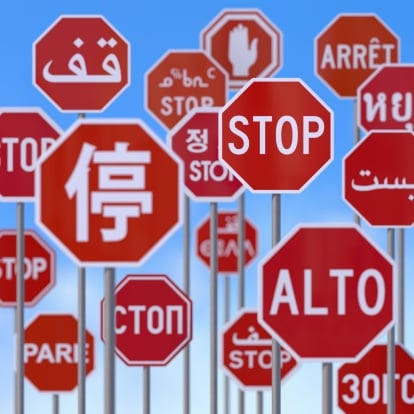You have /5 articles left.
Sign up for a free account or log in.

Getty Images
Overall enrollment in foreign language courses is down for the first time since about 1995, and enrollments in major European languages -- including Spanish -- are way down, according to a new report from the Modern Language Association. Language advocates aren’t sure what’s caused the drop, and say it’s too soon to tell whether it’s a fluke or the beginning of a new trend away from foreign language study. But they’re calling for a renewed effort in helping students see the value in upper-division language classes, which could be helpful to them in their careers.
“We don’t know if we’re seeing a blip, and we don’t know if this will continue,” said Rosemary Feal, executive director of the MLA, noting that the report is the first of its kind the MLA has completed since the recent recession; the organization runs enrollment data every few years, and the last report considered 2009 numbers, reflecting just the start of the downturn. “We don’t know if what’s happened is part of the overall decrease in humanities enrollments. One pressure that I think a lot of students are feeling is to concentrate all their educational eggs in baskets that appear to be career ready.”
MLA says enrollment in foreign language courses decreased 6.7 percent overall since 2009, after increasing steadily since 1995. Spanish remains the most-studied language, with more students than all other languages combined, but it took a big hit: enrollment is down 8.2 percent since 2009 -- the first drop for Spanish ever across institution types. French, the second-most-studied language, is down 8.1 percent, after a period of modest but steady growth. German -- which lost its third-most-popular-language slot to American Sign Language -- is down 9.3 percent, and Italian is down 11.3 percent. (MLA attributes some of rise of sign language to a difference in the way it counted enrollments in that field this year.) All those fields had seen steady if modest growth in recent surveys.
Gillian Lord, associate professor and chair of the department of Spanish and Portuguese studies at the University of Florida, said the national Spanish data “reflect our reality,” and those of peers she’s in touch with across the country. With more certainty than Feal, Lord said she thought the decline in Spanish enrollments was part of larger trend away from the humanities.
“Our students are under increasing pressure to go to college so that they can get a high-paying job upon graduation, which of course is a worthy goal, but what used to be the underlying assumptions behind that goal -- strength in liberal arts, broad disciplines, critical thinking, etc. -- seems to have fallen by the wayside in recent years,” she said via e-mail.
Lord said she also thought that Spanish and other programs had some modernizing to do, in that students aren’t enticed by the idea of just “reading the great works” anymore. Departments still have a lot to offer, she said, but they need to think more about how they sell it. Lord’s department, for example, recently created something called a Certificate in Spanish for the Professions, in which students gain cultural competencies, oral proficiency and specialized, professional knowledge of Spanish for careers in law, medicine and other fields.
sbJapanese and Arabic are down 7.8 percent and 7.5 percent, respectively, from 2009, after rapid growth since 2002. Russian is down 17.9 percent, and modern Hebrew is down 19.4 percent. Latin, AncientIs capping "Ancient" a house style thing? It's not in the style book. sb Greek and biblical Hebrew enrollments declined, as well.
MLA's report attributes at least part of the decline in enrollments to departments and programs shutting down entirely. The number of institutions reporting 5 of the 15 most commonly taught languages has fallen in recent decades. The number of institutions reporting enrollments in German, for example, was 1,356 in 1990. Today, it's 1,074. MLA assumes the missing data indicate program closures. Declines in overall enrollment in French, Ancient Greek, biblical Hebrew and Russian coincide with drops in reported enrollment data for 2013, the report says.
There was some growth in a few areas. Rapid growth in Chinese since 2002 slowed, but enrollment was still up 2 percent since 2009. Portuguese was up 10.1 percent at a time of increased interest in American higher education in ties with Brazil, and American Sign Language grew by 19 percent.
The biggest winner was Korean, with a 44.7 percent spike in enrollment.
Nojin Kwak, associate professor and director of the Nam Center for Korean Studies at the University of Michigan, wasn’t surprised by that figure, saying enrollment in Korean language courses on his campus has shot up by some 70 percent in the last five or six years. More students are taking Korean history, literature and culture classes, as well, he said.
Kwak said the demand was due to the influence of Korean popular culture, or the so-called Korean Wave. Students and prospective students often tell him they’re interested in Korean due to “K-Pop” (think PSY's 2012 hit song “Gangnam Style”) or “K-drama,” which they’re able to access over the Internet -- even if many of their high schools don't offer Korean. Kwak said he didn’t expect demand to decrease, even if PSY is a one-hit wonder, given the increasing geopolitical significance of the Korean peninsula.
Despite the bleakness of most of the report, Feal said she wasn’t alarmed. She said the issue requires further study, but that if students are in fact moving away from foreign languages due to concerns about finding a job upon graduation, they’re misguided. Feal said foreign language courses -- especially the upper-division courses that instill proficiency -- make students more marketable, not less. She said some students seemed to already understand this, pointing to data showing increased graduate enrollment in some languages. Feal also encouraged foreign language departments to think about how they can retain students beyond introductory-level courses.
Allegheny College’s Spanish enrollments are growing for third- and fourth-year classes, even though they’re declining slightly in earlier-level courses. Barbara Riess, associate professor and chair of modern and classical languages, said Allegheny doesn’t require students to take a foreign language, but encourages students to minor in something very different from their major. So many biology students who want to become doctors, for example, end up starting Spanish and sticking with it, she said.
“What I think Allegheny might be doing differently from other institutions is that emphasis is placed on different types of learning,” Riess said. “We don’t have a requirement for language but minors are studied in a deeper way, or connected in some way to the major, even if it’s connection by antithesis. It kind of broadens students’ minds.”
Language Enrollments and Percentage Change
|
Language |
Change from 2002-06 (%) |
Change from 2006-09 (%) |
Change from 2009-13 (%) |
2013 Enrollment (students) |
|
Spanish |
+10.3 |
+4.7 |
-8.2 |
790,756 |
|
French |
+2.0 |
+4.5 |
-8.1 |
197,757 |
|
American Sign |
+31.1 |
+15.5 |
+19.1 |
109,577 |
|
German |
+3.3 |
+1.6 |
-9.3 |
86,700 |
|
Italian |
+22.3 |
+2.7 |
-11.3 |
71,285 |
|
Japanese |
+25.2 |
+10.6 |
-7.8 |
66,740 |
|
Chinese |
+50.4 |
+16.5 |
+2 |
61,055 |
|
Arabic |
+126.6 |
+45.5 |
-7.5 |
32,286 |
|
Latin |
+7.8 |
+0.9 |
-16.2 |
27,192 |
|
Russian |
+3.5 |
+8.0 |
-17.9 |
21,962 |
|
Ancient Greek |
+12 |
-12.2 |
-35.5 |
12,917 |
|
Biblical Hebrew |
-0.3 |
-2.6 |
-8.7 |
12,551 |
|
Portuguese |
+23 |
+9.3 |
+10.1 |
12,415 |
|
Korean |
+37.1 |
+18.2 |
+44.7 |
12,229 |
|
Modern Hebrew |
11.6 |
-13.6 |
-19.4 |
6,698 |
|
Other languages |
33.6 |
21.4 |
-2.6 |
40,059 |
|
Total |
+12.9 |
+6.2 |
-6.7 |
1,562,179 |





